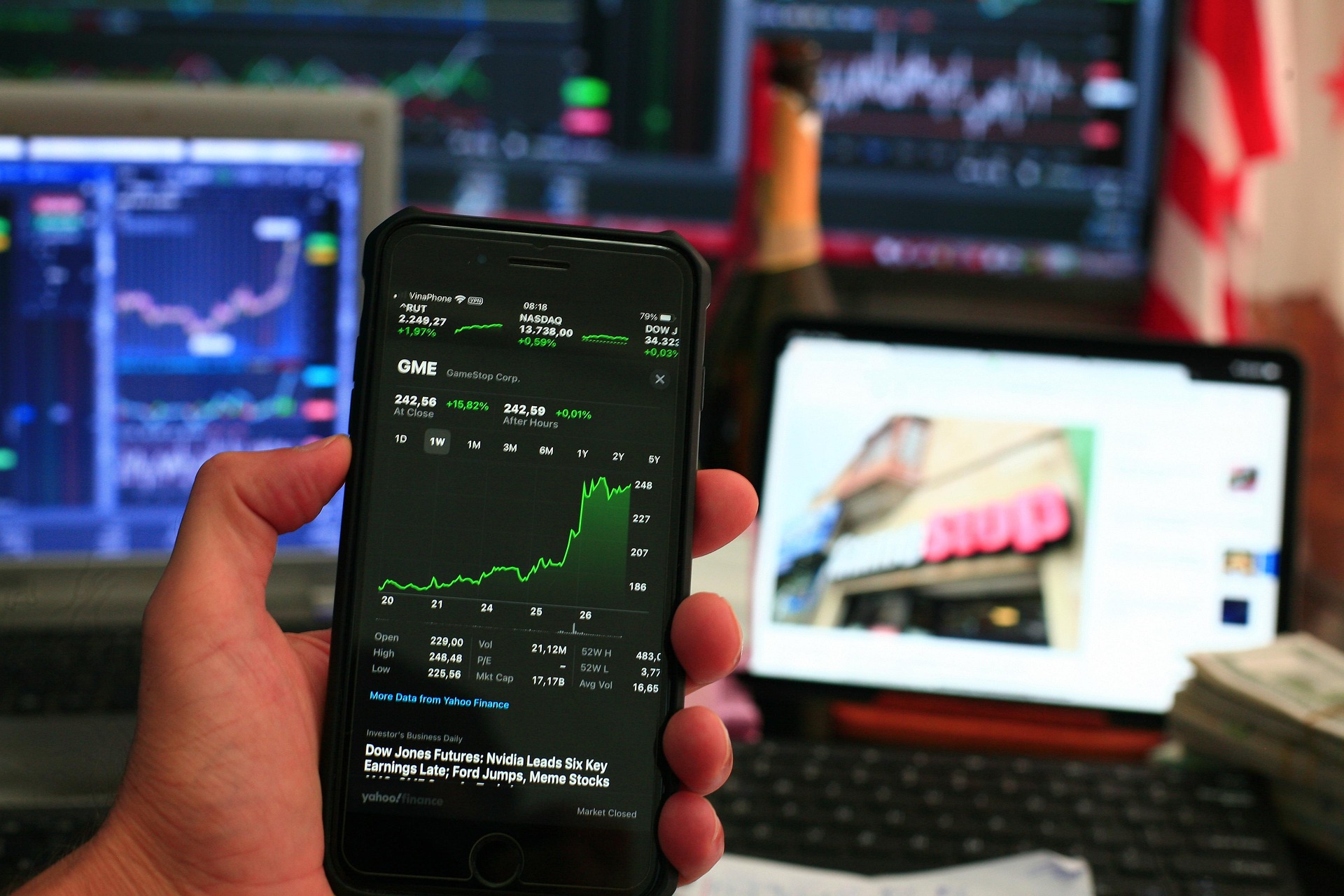Stock Market Today: Latest News, U.S. & Dow Jones Updates | Is the Market Open?

The stock market today is experiencing major shifts, influencing investments worldwide.
Stay updated on the market updates, U.S. stock market today movements, and Dow Jones stock market today trends.
Investors are closely watching stock market news today to analyze gains and losses.
But first, is the stock market open today? Knowing trading hours is essential for planning strategies and making informed decisions. Global events, inflation concerns, and Federal Reserve policies are shaping the U.S. stock market today.
The Dow Jones stock market today remains volatile as investors react to earnings reports and economic data.
Staying informed on stock market news today helps traders anticipate market direction.
Before making investment decisions, it’s crucial to check is the stock market open today to align with trading opportunities.
Many investors are also looking into NASDAQ’s latest performance trends
and how technology is impacting trading, such as AI-powered market predictions.
Stock Market Today: Latest Trends & Analysis

Current Market Performance
The stock market today is seeing mixed performance as investors react to economic data and corporate earnings.
Major indices, including the Dow Jones, S&P 500, and Nasdaq, continue to experience volatility.
Analysts point to inflation concerns and interest rate policies as key drivers of market sentiment.
For those tracking the U.S. stock market today, understanding these shifts is crucial for making informed investment decisions.
NASDAQ & Technology Sector Updates
In recent sessions, the Dow Jones stock market today has shown fluctuations as investors assess global economic conditions.
Meanwhile, technology stocks have influenced the Nasdaq’s performance, with many looking at
NASDAQ market trends
for deeper insights. The latest stock market news today also highlights how
corporate earnings reports are impacting investor confidence. Before making any trades,
it’s always important to check is the stock market open today and understand
market hours to avoid unexpected closures.
Dow Jones Stock Market Today: Key Movements & Insights
Market Volatility and Economic Trends
The Dow Jones stock market today remains a focal point for investors, reflecting broader economic conditions.
With shifting investor sentiment, the index has experienced fluctuations driven by corporate earnings,
interest rate decisions, and global financial trends. Analysts suggest that tracking the U.S. stock market today
alongside the Dow can provide a clearer picture of market momentum.
Sector Performance and AI’s Influence
Recent stock market news today highlights mixed performances in major Dow components,
including financial and industrial stocks. While some companies report strong quarterly earnings,
others struggle due to economic uncertainty. Investors looking for broader perspectives may find insights
in AI’s growing role in financial markets,
as automation and algorithmic trading increasingly impact stock movements.
Checking Market Hours Before Trading
Before making market moves, traders must ask, is the stock market open today?
Understanding trading hours is crucial, especially for those dealing with pre-market or after-hours trades.
For official opening and closing times, visit NYSE’s market hours page.
Stock Market News Today: What’s Driving Market Movements?
Market Trends and Economic Indicators
The latest stock market news today reveals that investors are closely monitoring inflation trends,
Federal Reserve policies, and global economic developments. As the U.S. stock market today reacts to new data,
volatility remains a key concern. Traders are paying attention to corporate earnings and how major indices,
including the Dow Jones stock market today, respond to changing economic indicators.
The Role of AI in the Stock Market Today
One major factor influencing the stock market today is the rise of AI-driven trading strategies.
Advanced algorithms are reshaping investment patterns, with many institutions integrating artificial intelligence
for predictive analytics. Investors interested in this trend can explore
how quantum AI is transforming stock trading.
This shift highlights the growing role of technology in shaping modern financial markets.
Checking Market Hours Before Trading
Before executing trades, it’s always essential to ask, is the stock market open today?
Unscheduled closures or shortened trading days can impact market strategies. For a complete overview of trading schedules,
visit official NYSE market hours.
Stock Market Trends: Key Factors Impacting Performance
Inflation and Federal Reserve Policies
One of the biggest concerns for investors in the U.S. stock market today is inflation.
As the Federal Reserve adjusts interest rates to control rising prices, market movements become highly volatile.
Higher rates can lead to lower corporate profits, affecting the Dow Jones stock market today
and overall market performance. Investors tracking the latest stock market news today
are closely watching inflation trends and their impact on stock values.
Global Economic Developments
Beyond domestic policies, international factors also shape the stock market today.
Economic slowdowns in major economies, trade tensions, and geopolitical conflicts
can send shockwaves through the market. The U.S. stock market today often reacts
to global events, with traders assessing risks and opportunities in real-time.
For deeper insights into how economic trends influence market movements,
NASDAQ market trends
provide valuable data on emerging patterns.
Sector-Specific Trends and Growth Opportunities
Each sector of the stock market responds differently to economic changes.
While technology and healthcare stocks may thrive in certain conditions,
energy and financial sectors could face challenges. Investors monitoring
the Dow Jones stock market today must assess sector performance
to identify potential growth opportunities. Additionally, understanding
AI’s role in finance
can help investors stay ahead of technological shifts influencing market trends.
Investor Sentiment and Market Reactions
Investor sentiment plays a crucial role in market performance.
Bullish trends drive stock prices higher, while bearish sentiment leads to sell-offs.
Analyzing investor confidence through trading volumes and market indicators
helps traders make informed decisions. Those wondering, is the stock market open today,
must also consider pre-market and after-hours trading activity,
which can provide early signals on market direction.
For official market hours, visit NYSE trading schedule.
Market Volatility: Understanding Risks and Opportunities
Causes of Stock Market Volatility
Fluctuations in the stock market today are influenced by multiple factors,
including economic reports, geopolitical events, and corporate earnings.
The U.S. stock market today has seen increased volatility
due to changing Federal Reserve policies and inflation concerns.
Investors tracking stock market news today must assess risk factors
affecting market performance.
How Investors Respond to Market Swings
When the Dow Jones stock market today experiences sharp movements,
investors often shift strategies. Some adopt defensive positions in stable industries,
while others take advantage of lower stock prices to increase holdings.
Understanding market volatility helps traders make informed decisions
and mitigate losses during downturns. Those wondering, is the stock market open today,
should check trading hours before making investment moves.
Impact of AI and Algorithmic Trading
Artificial intelligence plays a growing role in shaping volatility within the stock market.
Automated trading systems react to market data instantly,
sometimes intensifying fluctuations in the U.S. stock market today.
To better understand how AI is transforming stock trading,
explore quantum AI trading strategies.
These advanced systems can execute trades in milliseconds,
leading to rapid market shifts.
Managing Risk in a Volatile Market
Investors navigating the stock market today
must develop strategies to minimize risks.
Diversification, stop-loss orders, and long-term planning
are key approaches to handling market uncertainty.
For those interested in risk management techniques,
SBA programs and resources
offer financial insights useful for businesses and investors alike.
Investment Strategies in the Current Market
Long-Term vs. Short-Term Investing
Investors in the stock market today
must decide between long-term and short-term investment strategies.
Short-term traders rely on market fluctuations to generate quick profits
through day trading or swing trading, closely monitoring the
U.S. stock market today for volatility.
In contrast, long-term investors focus on fundamental analysis,
buying strong stocks and holding them for years to benefit from
compounding returns and market growth.
For those adopting a long-term strategy, stocks in industries such as
technology, renewable energy, and artificial intelligence
offer significant potential. Tracking stock market news today
helps investors identify market trends, earnings reports,
and economic indicators that shape long-term opportunities.
Diversification for Risk Management
Managing risk is essential in an unpredictable market.
Diversification involves spreading investments across different asset classes
to minimize losses when certain sectors underperform.
Investors in the Dow Jones stock market today
often balance their portfolios with a mix of stocks, bonds,
commodities, and real estate.
A well-diversified portfolio may include:
- Blue-chip stocks: Stable companies with strong financials.
- Growth stocks: High-potential companies, often in technology.
- Dividend stocks: Companies that offer consistent payouts.
- Alternative assets: Gold, real estate, and cryptocurrency.
Additionally, understanding how AI is shaping financial markets
can help investors optimize their asset allocation.
Identifying Growth Sectors
Economic trends and technological advancements influence
the performance of various industries. The U.S. stock market today
shows increased investor interest in sectors poised for long-term expansion.
Key growth industries include:
- Technology: AI, cloud computing, and semiconductor companies.
- Healthcare: Biotech firms, pharmaceutical stocks, and medical tech.
- Renewable Energy: Solar, wind, and EV-related industries.
- Financial Technology (FinTech): Digital payments and blockchain solutions.
Investors seeking opportunities in innovation-driven stocks
can explore NASDAQ market insights
for data on top-performing companies in these industries.
Safe-Haven Investments During Market Uncertainty
During periods of economic uncertainty, investors often turn to
safe-haven assets to protect their wealth. These include:
- Gold: Historically a hedge against inflation and market downturns.
- U.S. Treasury Bonds: Low-risk investments backed by the government.
- Dividend-Paying Stocks: Companies with consistent cash flow and stability.
- Defensive Sectors: Consumer staples, utilities, and healthcare.
These assets tend to hold their value even when the broader market declines.
Understanding Market Timing
Investors often ask, is the stock market open today,
especially when planning trades around major economic events.
Market timing involves analyzing price patterns, economic data,
and investor sentiment to determine the best entry and exit points.
Key strategies include:
- Dollar-Cost Averaging (DCA): Investing a fixed amount regularly, reducing risk.
- Sector Rotation: Moving investments into sectors expected to perform well.
- Value Investing: Buying undervalued stocks with strong fundamentals.
- Momentum Trading: Capitalizing on trending stocks showing upward momentum.
To check official trading hours, visit
NYSE market schedules.
Is the Stock Market Open Today? Understanding Trading Hours and Market Sessions
Regular Trading Hours for the U.S. Stock Market Today
One of the most common questions investors ask is,
“Is the stock market open today?”
The U.S. stock market today operates Monday through Friday
from 9:30 AM to 4:00 PM ET. These hours apply to major exchanges
such as the New York Stock Exchange (NYSE) and NASDAQ.
However, trading hours can be affected by federal holidays,
early closures, and special circumstances. Investors tracking
the Dow Jones stock market today
must be aware of any deviations from the regular schedule.
For an updated calendar, visit the
NYSE market schedule.
Pre-Market and After-Hours Trading in the U.S. Stock Market Today
Trading activity does not end when markets close.
The stock market today also has extended sessions
for investors who want to react to economic news,
earnings reports, or global developments.
- Pre-Market Trading: 4:00 AM – 9:30 AM ET
- Regular Trading: 9:30 AM – 4:00 PM ET
- After-Hours Trading: 4:00 PM – 8:00 PM ET
After-hours and pre-market sessions tend to have lower liquidity
and higher volatility. Traders monitoring
stock market news today
often use these sessions to position themselves before the next opening.
Stock Market Holidays and Early Closures
Investors must be aware of scheduled market closures
to avoid disruptions in their trading plans.
The Dow Jones stock market today follows
the official U.S. financial calendar, which includes:
- Full Market Closures: New Year’s Day, Independence Day, Thanksgiving, Christmas.
- Early Closures: Markets close at 1:00 PM ET on Christmas Eve and Black Friday.
These schedules apply to both NYSE and NASDAQ.
For the full list of upcoming closures, refer to
the NYSE trading calendar.
How the U.S. Stock Market Today Aligns with Global Trading Hours
Since the stock market is influenced by global events,
tracking international market sessions is crucial.
The U.S. stock market today reacts
to movements in Asian and European markets.
- Asian Markets: Open from 8 PM – 4 AM ET (Tokyo, Hong Kong, Shanghai).
- European Markets: Open from 3 AM – 11:30 AM ET (London, Frankfurt, Paris).
Global trading hours can affect the
Dow Jones stock market today,
especially in sectors with high international exposure.
Best Time to Trade in the Stock Market Today
Not all trading hours are equal in terms of liquidity and volatility.
Understanding the best time to trade in the
U.S. stock market today
can help investors make better decisions.
Most Active Trading Hours
- Market Open (9:30 AM – 11:30 AM ET): High volume, strong price movements.
- Midday Session (11:30 AM – 2:00 PM ET): Lower volatility, consolidation phase.
- Market Close (2:00 PM – 4:00 PM ET): Increased activity, institutional trades.
Traders focused on momentum trading
often prefer the opening and closing sessions,
as seen in the stock market today.
Those using long-term strategies
monitor market movements for better entry points.
How to Check if the Stock Market is Open Today
Investors frequently search, “Is the stock market open today?”
before making trading decisions. The easiest ways to check
the market status include:
- Visiting the NYSE official trading schedule.
- Checking financial news sources like CNBC and Bloomberg.
- Using brokerage platforms that display real-time market hours.
Why Trading Hours Matter for Investors
Understanding trading hours is crucial for optimizing investments.
The U.S. stock market today
operates within a global financial system,
and strategic timing can impact profitability.
For investors looking at tech-driven opportunities,
AI-driven trading strategies
provide new ways to navigate market hours effectively.
Factors Affecting the U.S. Stock Market Today
How Economic Data Impacts the U.S. Stock Market Today
Investors tracking the U.S. stock market today
must pay close attention to economic data releases.
Key reports such as GDP growth, inflation rates, and job numbers
can drive major price movements in the market.
Key Economic Indicators to Watch
- Gross Domestic Product (GDP): Measures economic growth.
Higher GDP growth often boosts the Dow Jones stock market today. - Inflation Reports (CPI & PPI): Rising inflation can cause
volatility in the stock market today, as investors
anticipate interest rate changes. - Employment Data: The U.S. jobs report influences investor confidence
and affects stocks in key sectors.
For a deeper look into how AI is transforming financial markets,
check out AI in finance and stock trading.
Federal Reserve Policies and Their Effect on the Dow Jones Stock Market Today
Interest rate decisions by the Federal Reserve play a critical role
in shaping market movements. When the Fed raises rates, borrowing costs increase,
which can slow down economic growth and impact stock prices.
How Interest Rate Changes Affect Stocks
- Rate Hikes: Can cause stock market declines
as borrowing costs rise for businesses. - Rate Cuts: Often fuel a rally in the
U.S. stock market today
by making credit cheaper and boosting spending. - Fed Statements: Even small changes in language
from the Fed can trigger reactions in the market.
Investors closely follow Fed meetings to anticipate
the direction of interest rates. Financial analysts
often look at Fed minutes to predict future policies.
Stock Market News Today: How Global Events Influence Market Trends
Global events have a significant impact on the
stock market news today.
Political tensions, trade deals, and international conflicts
can create volatility in major stock indices.
Geopolitical Risks and Market Reactions
- Trade Agreements: U.S. trade policies
affect market sectors such as tech, agriculture, and energy. - Oil Price Fluctuations: Changes in crude oil prices
impact energy stocks and inflation trends. - Political Instability: Elections, policy changes,
and global conflicts influence investor sentiment.
Keeping up with stock market news today
can help traders adjust their strategies in response
to geopolitical shifts.
Market Sentiment and Investor Behavior in the Stock Market Today
Beyond economic data and policy changes,
market sentiment plays a crucial role in
the U.S. stock market today.
Investor confidence determines whether markets rise or fall.
How Sentiment Drives Market Movements
- Fear & Greed Index: Measures investor sentiment
to determine whether stocks are overbought or oversold. - Earnings Reports: Strong earnings often push
the Dow Jones stock market today higher,
while weak earnings lead to sell-offs. - Market Speculation: Social media,
financial news, and investor sentiment
can trigger rapid price swings.
To understand stock market trends and future predictions,
visit NASDAQ market trends and forecasts.
Investment Strategies for Navigating Market Volatility
Understanding Market Cycles and How to Adapt
Financial markets move in cycles,
experiencing periods of expansion, contraction,
and recovery. Successful investors
analyze these cycles to adjust their portfolios
and manage risk effectively.
Key Phases of Market Cycles
- Bull Market: Characterized by rising stock prices
and economic expansion. - Bear Market: Defined by declining stock values
and cautious investor sentiment. - Market Corrections: Short-term declines
that create potential buying opportunities.
Understanding historical patterns can help investors
make more informed decisions, especially when managing
long-term financial goals.
Diversification: A Key to Reducing Risk
One of the most effective strategies
for mitigating losses is diversification.
By spreading investments across different asset classes,
sectors, and geographical regions, investors can
reduce the impact of market fluctuations.
Ways to Build a Diversified Portfolio
- Stocks and Bonds: Balancing equity investments
with fixed-income securities. - Sector Allocation: Investing in industries
that perform differently under various economic conditions. - International Exposure: Considering
global markets for added stability.
For additional strategies on balancing risk,
explore AI-powered trading solutions.
Long-Term vs. Short-Term Investment Approaches
Investors often choose between
long-term strategies that focus on growth
and short-term tactics aimed at capitalizing
on immediate market movements.
Which Strategy Works Best?
- Long-Term Investing:
Ideal for retirement accounts and wealth accumulation. - Swing Trading:
Medium-term approach focused on capitalizing on price swings. - Day Trading:
Short-term strategy involving rapid buying and selling.
Each approach has its advantages,
and selecting the right one depends
on an individual’s risk tolerance and financial goals.
How Market News and Trends Influence Investment Decisions
Staying informed about economic developments,
corporate earnings, and financial policies
can help investors make more confident decisions.
Major financial news platforms and brokerage tools
provide insights that guide market strategies.
Where to Find Reliable Market Insights
- Bloomberg Markets
for in-depth financial analysis. - CNBC
for real-time stock updates and expert opinions. - Resources on financial planning
for business owners and investors.
By combining market research with proven strategies,
investors can navigate fluctuations more effectively
and position themselves for long-term success.
Stock Market Trends: Key Drivers and Future Predictions
Market Trends Shaping the U.S. Stock Market Today
The financial markets are constantly evolving,
influenced by technological advancements,
economic cycles, and investor behavior.
Understanding the forces shaping the
U.S. stock market today
can help traders and long-term investors
make informed decisions.
Current Trends Influencing the Market
- Technology Stocks: AI, cloud computing,
and semiconductor companies continue to drive market growth. - Inflation and Interest Rates:
Economic policies affect market stability and sector performance. - Energy and Commodities:
Oil and raw material prices impact key industries. - Consumer Spending:
Retail and e-commerce trends shape economic momentum.
For deeper insights into how AI is influencing financial decisions,
check out AI’s impact on the financial sector.
How the Dow Jones Stock Market Today Reflects Economic Conditions
The Dow Jones Industrial Average serves as
a key indicator of economic health.
Movements in the Dow Jones stock market today
reflect investor sentiment, corporate earnings, and macroeconomic trends.
Key Factors Affecting the Dow
- Corporate Earnings: Quarterly reports
can cause significant fluctuations. - Federal Reserve Announcements:
Monetary policies impact investment strategies. - Sector Rotation: Market shifts between
growth and value stocks based on economic conditions.
To understand sector-specific movements,
explore NASDAQ performance trends.
Future Predictions for the Stock Market
While predicting market movements with certainty
is impossible, analysts consider economic indicators
and historical patterns to forecast potential trends.
Stock Market Outlook for the Next Year
- Technology Growth: Continued AI and
automation investments could drive stock market gains. - Inflation Control: Stabilized inflation
could lead to improved consumer confidence. - Global Markets: International trade
and geopolitical stability may influence long-term growth.
For a deeper look at stock market forecasts,
check out insights from
CNBC’s market analysis.
Impact of Economic Policies on Market Performance
How Government Policies Shape Financial Markets
Economic policies set by central banks and government institutions
have a direct influence on financial markets.
Decisions related to taxation, monetary policy,
and fiscal spending can create shifts in investor sentiment
and market stability.
Key Policy Decisions That Influence the Market
- Interest Rate Adjustments:
Higher rates can slow economic growth, while lower rates often fuel market rallies. - Tax Policies:
Changes in corporate tax rates affect business profitability and stock valuations. - Government Stimulus:
Spending programs can boost consumer demand and corporate earnings.
For an in-depth look at government-backed financial programs,
visit Small Business Administration initiatives.
Monetary Policy and Its Effect on Market Trends
Central banks, particularly the Federal Reserve,
use monetary policy tools to manage inflation,
employment levels, and financial stability.
Their decisions impact borrowing costs, liquidity,
and overall market sentiment.
How Monetary Policy Affects Investments
- Expansionary Policy:
Lower interest rates and increased money supply support stock market growth. - Contractionary Policy:
Higher rates and reduced money supply can lead to market slowdowns. - Inflation Control Measures:
Efforts to curb inflation influence consumer spending and corporate earnings.
For insights on how advanced technology is influencing market strategies,
check out Quantum AI trading systems.
Global Trade and Market Reactions
International trade agreements, tariffs,
and supply chain disruptions can create volatility in financial markets.
Shifts in global trade policies often impact key industries
such as technology, manufacturing, and agriculture.
Major Factors Influencing Global Markets
- Trade Agreements:
New trade deals can benefit certain sectors while negatively affecting others. - Currency Fluctuations:
Changes in exchange rates affect multinational corporations and investment returns. - Commodity Prices:
Oil, metals, and agricultural prices play a significant role in market stability.
Keeping up with economic trends can help investors
navigate market fluctuations.
For more on financial planning and business strategies,
read this guide on business resources.
The Role of Institutional Investors in Market Movements
How Large-Scale Investors Influence Market Trends
Institutional investors, including hedge funds, pension funds,
and mutual funds, play a significant role in shaping financial markets.
Their large capital allocations can drive price movements,
impacting liquidity and overall market sentiment.
Key Institutional Players in the Market
- Mutual Funds: Diversified investment vehicles
that pool capital from retail and institutional investors. - Pension Funds: Long-term investment funds
focused on stable returns and risk management. - Hedge Funds: Actively managed funds
that use various strategies to maximize gains. - Investment Banks: Institutions that provide
market liquidity and corporate financing solutions.
For insights into how technology is transforming financial markets,
explore AI-driven financial strategies.
How Institutional Investors Impact Stock Prices
When large financial institutions buy or sell stocks in bulk,
they create ripple effects throughout the market.
Understanding their trading patterns can help retail investors
make more informed decisions.
Ways Institutional Activity Affects the Market
- Liquidity Boost:
Higher trading volumes can enhance market efficiency. - Volatility Spikes:
Large trades can cause sudden price fluctuations. - Sector Influence:
Heavy investment in specific industries can lead to market trends.
Retail investors often analyze institutional buying trends
to identify strong investment opportunities.
For additional trading strategies,
check out AI-powered trading techniques.
Retail Investors vs. Institutional Investors: Who Drives the Market?
While institutional investors control significant portions of capital,
retail investors have gained more influence in recent years,
partly due to online trading platforms and social media-driven stock movements.
Key Differences Between Retail and Institutional Investors
| Factor | Institutional Investors | Retail Investors |
|---|---|---|
| Capital Size | Billions in managed assets | Smaller individual portfolios |
| Trading Strategy | Long-term investment and hedging | Short-term and speculative trades |
| Market Impact | Significant influence on stock prices | Growing influence through social investing |
Both groups play vital roles in financial markets,
and understanding their strategies can provide a competitive edge.
For more insights into investment opportunities,
read NASDAQ market trends and predictions.
Emerging Technologies Shaping Financial Markets
The Rise of AI and Machine Learning in Trading
Advanced technologies are reshaping how financial markets operate.
Artificial intelligence (AI) and machine learning (ML)
are now used to analyze vast amounts of data,
identify trading patterns, and execute trades faster than humans.
How AI is Transforming Trading Strategies
- Algorithmic Trading: AI-driven algorithms
execute trades based on predefined conditions. - Sentiment Analysis: AI tools analyze news,
social media, and financial reports to predict market movements. - Risk Assessment: Machine learning models
evaluate potential risks and optimize portfolio management.
For a deeper dive into AI’s role in financial markets,
explore AI in finance.
Blockchain and Cryptocurrency: Changing the Financial Landscape
The adoption of blockchain technology and digital currencies
has introduced new investment opportunities and challenges.
Decentralized finance (DeFi) platforms allow investors
to access financial services without traditional intermediaries.
Key Innovations in Blockchain and Crypto
- Cryptocurrencies: Bitcoin, Ethereum,
and other digital assets continue to influence global finance. - Smart Contracts: Automated agreements
that execute transactions without middlemen. - Stablecoins: Digital currencies pegged to fiat money
to reduce volatility.
For insights on advanced trading technologies,
check out Quantum AI trading.
Big Data and Predictive Analytics in Market Forecasting
Big data analytics allows investors and financial institutions
to process massive datasets and make informed decisions.
Predictive models analyze historical market trends
to forecast future movements with higher accuracy.
How Big Data Enhances Market Analysis
- Real-Time Data Processing:
Faster insights for quicker investment decisions. - Automated Risk Management:
Predictive tools help minimize investment risks. - Portfolio Optimization:
Data-driven strategies improve asset allocation.
As technology continues to evolve,
investors who embrace AI and data-driven strategies
gain a competitive edge in the market.
Regulatory Challenges and Future Developments
With the rapid growth of financial technology,
governments and regulatory bodies are working
to establish frameworks that ensure security
while fostering innovation.
Key Regulatory Considerations
- Compliance Requirements:
New regulations impact algorithmic and high-frequency trading. - Crypto Regulations:
Governments worldwide are creating guidelines for digital assets. - Consumer Protection:
Efforts to safeguard investors from fraud and cyber threats.
For more on government-backed financial programs,
read this guide on business resources.
Market Volatility and Risk Management Strategies
Understanding Market Volatility and Its Causes
Market volatility is a natural part of financial systems,
influenced by economic events, geopolitical developments,
and investor sentiment. Sudden price fluctuations
can create risks but also present trading opportunities.
Common Factors That Drive Market Volatility
- Economic Reports: GDP growth, employment data,
and inflation rates impact market confidence. - Interest Rate Decisions:
Central bank policies influence stock and bond markets. - Political and Global Events:
Trade agreements, elections, and conflicts can trigger instability.
For insights into long-term financial strategies,
read NASDAQ market trends.
Risk Management Strategies for Investors
To navigate volatile markets, investors use risk management strategies
to protect their portfolios and maximize returns.
Essential Risk Management Techniques
- Diversification:
Spreading investments across different asset classes
reduces exposure to market downturns. - Stop-Loss Orders:
Setting automatic sell orders prevents excessive losses. - Hedging Strategies:
Options and futures contracts help minimize risks.
For advanced risk-reduction techniques,
explore AI-powered trading solutions.
Long-Term Investment Approaches in a Volatile Market
Investors looking to build sustainable wealth
often focus on long-term strategies rather than reacting to short-term fluctuations.
Key Long-Term Investment Strategies
- Blue-Chip Stocks:
Investing in well-established companies with stable growth. - Index Funds and ETFs:
Passive investment options that follow market benchmarks. - Dollar-Cost Averaging:
Consistently investing fixed amounts over time to reduce risk.
Understanding market risks and implementing strong strategies
can help investors achieve long-term financial stability.
For insights into government-backed business programs,
visit this SBA resource guide.
Future Outlook: Where Are Financial Markets Headed?
Key Trends That Will Shape Financial Markets
The financial landscape is evolving rapidly,
driven by economic shifts, technological advancements,
and global market dynamics. Investors must stay informed
to navigate upcoming challenges and opportunities.
Major Trends to Watch
- Growth of Digital Assets:
Cryptocurrencies and tokenized securities
are gaining mainstream acceptance. - Expansion of AI in Trading:
Machine learning algorithms are enhancing market predictions. - ESG Investments:
More investors are prioritizing environmental, social,
and governance (ESG) factors in portfolio decisions.
For more insights on AI’s impact on finance,
check out this in-depth analysis.
The Impact of Global Economic Policies
Government policies and international trade agreements
play a crucial role in financial market performance.
Monetary policies set by central banks influence
interest rates, inflation, and currency values.
Factors That Could Drive Market Changes
- Federal Reserve Interest Rate Policies:
Adjustments in borrowing rates can impact investment flows. - Global Trade Agreements:
Changes in tariffs and economic alliances
affect international market stability. - Inflation Trends:
Rising inflation can lead to shifts in consumer spending
and corporate earnings.
To stay updated on stock market developments,
read market performance insights.
How Investors Can Prepare for the Future
Adapting to future market changes requires
a combination of research, strategic planning, and risk management.
Proactive Steps for Investors
- Stay Informed:
Monitor economic reports and global trends. - Diversify Investments:
Balance portfolios with multiple asset types. - Leverage Technology:
Use AI-driven tools for smarter investment decisions.
Is the stock market open today, check for strategies on integrating technology in trading,
visit Quantum AI trading.














